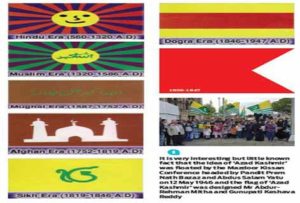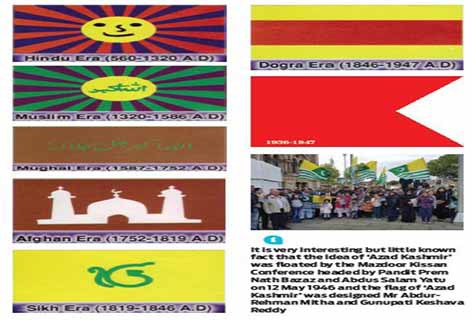 The history of Kashmir goes as far back as 3000 BC. Identified primarily with religion during most of the ancient history, Kashmir was a Hindu country except during 12th century BC to 6th Century AD when it remained the centre of Buddhism.
The history of Kashmir goes as far back as 3000 BC. Identified primarily with religion during most of the ancient history, Kashmir was a Hindu country except during 12th century BC to 6th Century AD when it remained the centre of Buddhism.
The first known flag of Kashmir appears from 560 AD to 1320 AD which is known as Buddhist and Hindu era.The sun smiles at the centre and its rays spread the light all over in this era of Kashmir history. The most illustrious period of this era was of the legendary King Lalit Aditiya (724-760) who is known as the Alexander of Kashmir for his conquests abroad and developments at home.
Muslim era in Kashmir began in early 14th century when a Tibetan Buddhist Rinchin converted to Islam after ascending to throne. It appears that a new flag was introduced in this period sun was replaced with the phrase ‘Allah O Akbar’; God is the Greatest’. The rays were kept but colours were changed to blue and green. The most prominent of the independent Kashmiri Muslim rulers was Zain ul Abidin (1419-1470) commonly known as the Budd Shah (the great King) who is remembered for his exemplary religious tolerance, educational and economic development and expansion of Kashmiri rule.
In 1586 Kashmir lost its independence to Mughals. Although Mughals were Muslims but they did not continue with the existing flag of Kashmir. They introduced their own flag with ‘Allah Akbar Jall Jalal’ (God the greatest and mightiest). Coincidently, the King of Mughal Emperor at the time was also called Jalal Uddin Akbar.
In 1752 Mughals were defeated by Afghans and Kashmir was taken into the realm of Durrani Empire. Once again although new rulers were Muslims but they too replaced the flag of Mughals with their own. They kept the brown background but changed the ‘God the greatest and mightiest’ with a white mosque with two minarets and a tomb in the middle with a crescent.
Afghans were replaced by the Punjabi Sikhs in 1819. With the change of rules flag was once again changed with Sikh religious symbol in the middle of a yellow background.
On 16th March 1846 following the Anglo-Sikh wars, the Sikh rulers were made to hand over Kashmir and adjacent territories to British East Indian Company in lieu of war indemnity. The British East India Company then transferred these territories in the independent possession of Raja Gulab Singh of Jammu for a sum of 7.5 million rupees. Thus was created the State of Jammu and Kashmir. From 1846 to 1947 successive Maharajas used the following flag. However, this needs further research as there is another flag which is claimed to be used from 1936 to 1947.
By 1930s the modern political ideas of democracy and socialism found their way to Kashmir through a wide range of sources including students, soldiers, political activists and traders who travelled to and from abroad including British India, Britain and wider Europe.
Responding to popular movement, the first assembly was establish in 1934 where less than half of the seats were open for elections in which certain subjects were entitled to vote. It is claimed that after that the following flag was used as the State flag.
1936-1947
The First Political party in Kashmir was formed in 1932 by the name of Jammu and Kashmir Muslim Conference (JKMC). It was changed to Jammu and Kashmir National Conference (JKNC) in 1938. This party presented the first modern political manifesto with a political programme titled ‘New Kashmir’ formally recognising the political religious and cultural diversity of Kashmir. The Flag this party introduced as the national flag reflected the agricultural nature of the Kashmir economy with Plough as the symbol of peasants’ prominence and three lines as the main regions of the state, Kashmir Valley, Jammu and Ladakh. Almost all Kashmiris in Rochdale are from Jammu region of Kashmir state. The red colour represented the socialist tendencies of National Conference.
However, in 1947 when India and Pakistan won freedom from British colonial rule, they invaded Kashmir. Subsequently, Kashmir was divided between Indian and Pakistani rule but the Kashmiri leadership on both sides of the division line managed to keep their distinct Kashmiri identity with their own flags and autonomy. The above flag is now used in what officially is called ‘Jammu and Kashmir’ and is controlled by India.
The part of Kashmir that came under Pakistani rule was further divided into two regions, ‘Azad Jammu and Kashmir’ and ‘Gilgit Baltistan’.
It is very interesting but little known fact that the idea of ‘Azad Kashmir’ was floated by the Mazdoor Kissan Conference headed by Pandit Prem Nath Bazaz and Abdus Salam Yatu on 12 May 1946 and the flag of ‘Azad Kashmir’ was designed Mr Abdur-Rehman Mitha and Gunupati Keshava Reddy. Both of the rebellions and the governments that were announced against the then Maharaja Hari Singh in Gilgit Baltistan and in what became known as ‘Azad Kashmir’ used the same flag of ‘Azad Kashmir’. However, soon the GB territories were taken over by Pakistan and later State Subject was also deferred in these regions.
Except an estimated 300 families mostly professionals from the India administered Kashmir Valley, most of nearly one million British Kashmiris originate from the ‘Azad Jammu and Kashmir’ area of the divided Kashmir administered by Pakistan. The government of ‘Azad Kashmir’ was announced on October the 4th and established on 24th October 1947. The flag below, which is used in Azad Kashmir, is also widely used in Britain by Kashmiri diaspora at various public gatherings and political processions.
Following the ceasefire brokered by the UN, both India and Pakistan promised to withdraw their forces, with Pakistan doing so first, and let the people of Kashmir decide their future status. This unfulfilled promise and the armies of India and Pakistan in Kashmir and the erosion of the autonomy and self-rule of Kashmiris remains the major cause of the Kashmir Conflict that has kept the Kashmir state and its over 20 million people in a constant state of uncertainty and vulnerability and their resources subject to continuous exploitation.
(Shams Rehman is a Kashmiri activist from Manchester, who is one of founders of the Kashmiri National Identity Campaign in the U.K, and campaigns for the recognition of Kashmiris as a distinct Ethnicity in Britain)





